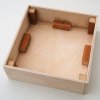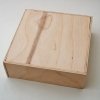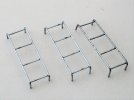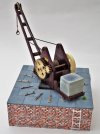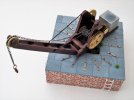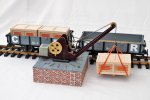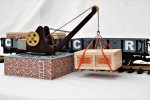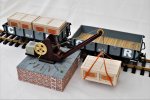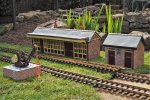David1226
Registered
Some time ago, more or less on a whim, I bought a Modeltown Easy Build Kit of a yard crane, at an exhibition. I thought it would make an interesting scenic item but I had no real thoughts on where to place it and it was put aside as a future project. When I redrew the trackplan for the Claptowte Railway, there was an obvious location for the crane on the midpoint of the goods loop at Gernise End Station. I opened the plastic bag that the kit came in and found that not only did the kit live up to its ‘easy build’ name tag, but it was pretty much assembled already. I actually had to dismantle the kit in order to paint the various component parts prior to final assembly. The following photo shows the kit in its dismantled state.
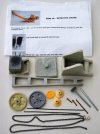
The only two parts that had to be glued together, initially, were the main body and the rear counterweight. The counterweight itself was moulded in a mottled grey resin that looked exactly like weathered concrete, I decided that this must be left unpainted. I carefully masked up the counterweight before giving the rest of the assembly, and any other components that required painting, a spray of grey plastic primer. The components were painted in the Claptowte Railway corporate colours of British Rail maroon and cream. After painting the main body i removed the masking from the ‘concrete’ block. I added a moderate amount of weathering where I thought appropriate. As I already stated, the kit was really easy to assemble into an attractive model.



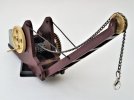
David

The only two parts that had to be glued together, initially, were the main body and the rear counterweight. The counterweight itself was moulded in a mottled grey resin that looked exactly like weathered concrete, I decided that this must be left unpainted. I carefully masked up the counterweight before giving the rest of the assembly, and any other components that required painting, a spray of grey plastic primer. The components were painted in the Claptowte Railway corporate colours of British Rail maroon and cream. After painting the main body i removed the masking from the ‘concrete’ block. I added a moderate amount of weathering where I thought appropriate. As I already stated, the kit was really easy to assemble into an attractive model.




David



